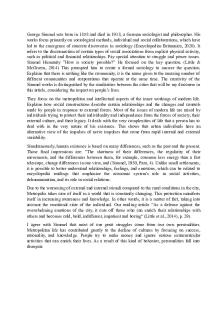Learning journal unit 6 PDF

| Title | Learning journal unit 6 |
|---|---|
| Author | Kimia Alikhani |
| Course | Introduction to Statistics |
| Institution | University of the People |
| Pages | 3 |
| File Size | 74 KB |
| File Type | |
| Total Downloads | 97 |
| Total Views | 125 |
Summary
Learning journal unit 6...
Description
1. Learning Journal Reflective Comments: 5 / 14 / 2021 I checked new lessons and prepared Word files to write my assignments in them. I review last week's lesson to understand this week's lessons precisely. 5 / 15 / 2021 I read the new lesson that call the normal distribution, it was a new issue for me so I did some extra research to understand it better. 5 / 16 / 2021 I review the lesson again and wrote half of the discussion post then took the self-quiz. I also took my grade quiz after reviewed all the materials. 5 / 17 / 2021 Today, I've done my discussion post with a relax mind of the person who took her grade quiz then I posted it. 5 / 18 / 2021 I've been working on my learning journal post today and I'm trying to choose between these functions: dnorm(), pnorm(), qnorm(), rnorm(). 5 / 19 / 2021 Today, I replied to three posts of my fellow students and rated their posts. I read their posts and bolster my knowledge, some of the posts were so good and detailed. 5 / 20 / 2021 Finally, I've done working on my learning journal and posted it.
2. Vocabulary and R functions (be sure to include an APA citation) a) What is a normal distribution? In my mind, the normal distribution use for continuous random variable. (Yakir,2011) According to Statics (n.d): "The normal distribution is important in statistics and is often used in the natural and social sciences to represent real-valued random variables whose distributions are unknown. The normal distribution is sometimes informally called the bell curve." b) What does the pnorm() function do? We use pnorm() function to computed the cumulative probability.(Yakir,2011,p.88) 3. Task If you know the mean and standard deviation of a normally distributed population, and somebody asks you questions about the highest 1% and lowest 1% of numbers in that population, what could you tell them? Pick your own values for the mean and standard deviation and then answer the question for those values. Choose one of these R functions to answer the question: dnorm(), pnorm(), qnorm(), rnorm().
I picked pnorm() function to answer this question: The normal distribution can show 1% of the population getting very high or getting very low scores, and we have the middle which is not low or high. On the right side of the curve we have 1% of the population and on the left side of the curve we have 1% of the population. For example, we can calculate accumulative probability of a 12 children whose the mean score of their drawing assignment is 96 and the standard deviation of 3, we can use the pnorm() function: > pnorm(12, 96 ,3) [1] 8.123869e-173 The cumulative probability is 8.12.
Reference:
Yakir. B, (2011). Introduction to Statistical Thinking (With R, Without Calculus). Retrieved from https://my.uopeople.edu/pluginfile.php/1097279/mod_book/chapter/267923/MATH1280RInstallNotes .pdf. Normal distribution calculator. Normal distribution calculator (statistics). (n.d.). https://www.hackmath.net/en/calculator/normal-distribution....
Similar Free PDFs

Learning Journal Unit 6
- 1 Pages

Learning Journal. Unit 6
- 3 Pages

Learning journal unit 6
- 3 Pages

MATH1201 Learning Journal Unit 6
- 2 Pages

Learning journal unit 4
- 3 Pages

Learning Journal Unit 1
- 2 Pages

CS 1103 Learning Journal Unit 6
- 2 Pages

Learning Journal Unit 8
- 2 Pages

Learning Journal Unit 3
- 2 Pages

Learning journal unit 3
- 2 Pages

Learning Journal unit 7
- 2 Pages

Learning Journal Unit 8
- 2 Pages

UNIT 3 Learning Journal
- 2 Pages

Learning Journal Unit 2
- 2 Pages
Popular Institutions
- Tinajero National High School - Annex
- Politeknik Caltex Riau
- Yokohama City University
- SGT University
- University of Al-Qadisiyah
- Divine Word College of Vigan
- Techniek College Rotterdam
- Universidade de Santiago
- Universiti Teknologi MARA Cawangan Johor Kampus Pasir Gudang
- Poltekkes Kemenkes Yogyakarta
- Baguio City National High School
- Colegio san marcos
- preparatoria uno
- Centro de Bachillerato Tecnológico Industrial y de Servicios No. 107
- Dalian Maritime University
- Quang Trung Secondary School
- Colegio Tecnológico en Informática
- Corporación Regional de Educación Superior
- Grupo CEDVA
- Dar Al Uloom University
- Centro de Estudios Preuniversitarios de la Universidad Nacional de Ingeniería
- 上智大学
- Aakash International School, Nuna Majara
- San Felipe Neri Catholic School
- Kang Chiao International School - New Taipei City
- Misamis Occidental National High School
- Institución Educativa Escuela Normal Juan Ladrilleros
- Kolehiyo ng Pantukan
- Batanes State College
- Instituto Continental
- Sekolah Menengah Kejuruan Kesehatan Kaltara (Tarakan)
- Colegio de La Inmaculada Concepcion - Cebu

